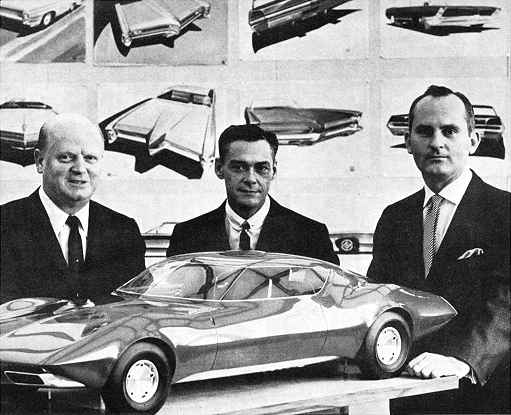 Standing behind a model that may be Pontiac of the future are: William Mitchell, GM styling vice president (left); Jack Humbert, design chief (center); and Charles Jordan, executive vice president in charge of automotive design — key men in Pontiac's '65 look. Standing behind a model that may be Pontiac of the future are: William Mitchell, GM styling vice president (left); Jack Humbert, design chief (center); and Charles Jordan, executive vice president in charge of automotive design — key men in Pontiac's '65 look.
|
|
 HE NEW STYLING direction for Pontiac, introduced with the 1965 models, comes as the creation of one of the most talented design teams in American industry. The fountain of Pontiac's new look is the ultra-modern studios of General Motors Styling, at the GM Technical Center in Detroit's suburb of Warren, Michigan.
HE NEW STYLING direction for Pontiac, introduced with the 1965 models, comes as the creation of one of the most talented design teams in American industry. The fountain of Pontiac's new look is the ultra-modern studios of General Motors Styling, at the GM Technical Center in Detroit's suburb of Warren, Michigan.
Its creators are a talented team of designers led by William L. Mitchell, GM vice president in charge of styling, who directs the design of all GM automobiles, appliances, and other products. The other two key men in the Pontiac design story are Charles M. Jordan, styling's executive in charge of automotive exterior design, and Jack N. Humbert, chief of the Pontiac styling studio.
Besides the now-familiar split grille, a special trademark of the Pontiac look for 1965, is the characteristic "venturi" or "Coke-bottle" shape. This dictates that the major profile lines be thin at the doors and flow both upward and downward at the rear quarter. This year the venturi is emphasized by a skeg extended down and out along the lower edge of the quarter panel.
"This new design greatly enhances Pontiac's lean, aggresive look and youthful appeal," Mitchell points out. "The car has more of a look of motion. Even standing it seems poised for action."
Pontiac's distinctive front end continues the traditional split-grille theme, emphasized by a more sharply pointed and further extended prow in the center. The prow lines are also carried prominently back along the hood surface. The vertically stacked headlamps, a popular Pontiac-originated design, are emphasized by a tube-like chrome mounting, with the upper lamp set ahead of the lower and the front fender line angled forward to partially hood the upper lamp.
"This new design theme is more three-dimensional in its approach, and it gives a smooth-flowing and better integrated shape," Mitchell explains. "It's a departure from the flat planes, squared lines, separated uppers and lowers, and flat-faced fronts and rears that characterized past design themes."
|
|